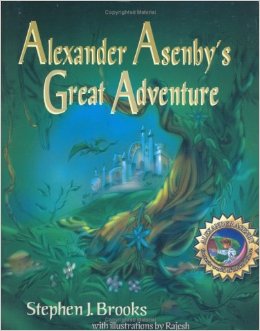Stephen J. Brooks, a former federal agent, is a writer of children’s books, and two of his newest happened to cross my desk. I think it’s probably an open secret at this point that I enjoy children’s literature, with a special fondness for illustrated books, and I was very pleased to have a chance to look at these.
 Alexander Asenby’s Great Adventure is the first of a series about Alexander, who enters the world of make-believe through his closet door at night when everyone else is sleeping. This time, he dons his shining armor and mounts his trusty dragon and takes off for the realm of the fairies, who have planned a great feast. Alas! The town is being attacked by ogres and trolls, and Alexander must fly off to the rescue. After chasing the bad guys off, Alexander returns to the feast (which seems to have a preponderance of cake and cookies as part of the repast), and, when the time is right, back to his bed.
Alexander Asenby’s Great Adventure is the first of a series about Alexander, who enters the world of make-believe through his closet door at night when everyone else is sleeping. This time, he dons his shining armor and mounts his trusty dragon and takes off for the realm of the fairies, who have planned a great feast. Alas! The town is being attacked by ogres and trolls, and Alexander must fly off to the rescue. After chasing the bad guys off, Alexander returns to the feast (which seems to have a preponderance of cake and cookies as part of the repast), and, when the time is right, back to his bed.
The illustrations by Rajesh are appealing, calling to mind some of the better examples from the Disney studios of the era of Bambi, and also drawing very effectively on the traditions of Rajesh’s native India with their rich colors and sinuous forms. They are beautifully done and add another dimension to the story by their humorous depiction of the ogres — not to mention the blue-eyed and somewhat quizzical dragon.
 Creatures of the Night is a rather different book, oriented toward demystifying the nighttime through a survey of the animals who inhabit the dark hours. We see the birds and squirrels and rabbits coming home to their nests and burrows and tree hollows as the moon is rising, while the raccoons and owls and field mice, among others, come out to play. It’s what I call a “survey” book, listing in verse the various animals and placing them in a context that inspires confidence in very young children.
Creatures of the Night is a rather different book, oriented toward demystifying the nighttime through a survey of the animals who inhabit the dark hours. We see the birds and squirrels and rabbits coming home to their nests and burrows and tree hollows as the moon is rising, while the raccoons and owls and field mice, among others, come out to play. It’s what I call a “survey” book, listing in verse the various animals and placing them in a context that inspires confidence in very young children.
Rodger Wilson’s illustrations for this one are a strong departure from those by Rajesh in the first book. They possess a more graphic quality along with a muted palette and a style more in keeping with the art of the naïve than the polished, elegant fantasies in Alexander Asenby, which I think might bring a stronger identification from children who are, in all probability, making their own first attempts at drawing.
On the whole, I found both books delightful, although I do question the stated age range: Alexander Asenby, at least, is noted as directed toward children from kindergarten to third grade, although both strike me as being more suitable for very young children. I have some quibbles — the verses don’t always scan, and I defy anyone to explain “mesmerizing” to a young child — but the books look to be ideal bedtime reading and the illustrations will, I think, prove as attractive to children as they did to me.
(Both Purple Sky Publishing 2005)
